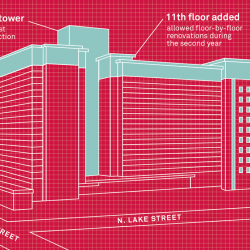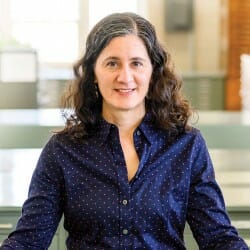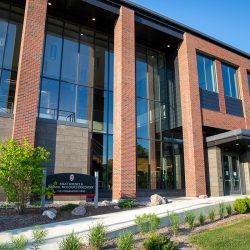Signature Signatures
Their genesis unknown, the names of geography students mark the decades.
After seven years of exams, late nights, long field studies, publishing work in top scientific journals, and writing and revising and perfecting a doctoral thesis, there was one more thing Jacquelyn Gill MS’08, PhD’12 needed to do before she could feel like her doctorate in geography was complete: autograph a brick.
Just down the stairwell from the fifth-floor loft where the grad students toil away in Science Hall, Gill added her name and graduation year to the parting thoughts left by the students who — for as many as one hundred and twenty years — have called the building home.
“Putting my name up there was a sort of final rite of passage, and it was always nice seeing the names of those who graduated before me,” Gill says.
People know very little about the practice in the building, which was constructed in 1887 and to this day sustains ghost stories. “The names had been there forever — even when I showed up,” says Jude Leimer MS’82, managing editor of the History of Cartography Project, and a graduate student in Science Hall in the early 1980s.
“What I heard was, every so often, someone would find a ladder and climb up high, and scrawl their initials and graduation date,” says Thomas Tews MA’90, geography librarian and a Science Hall resident since 1984.
Among the oldest legible autographs are somewhat familiar names such as Frank M. Reilly, a Madison architect who, despite never completing a UW degree, carefully signed his name and added a date — January 16, 1897 — before he left campus.
The inherent tension of academia comes through a little, too, in notes such as one left just a decade ago: “When I look back on this year, it will be with sheer disdain.”
Most students take care not to mar the marks of their predecessors, and they choose to leave on a happy and thoughtful note: Gill, for example, paired her name with a quote from poet Mary Oliver: “To pay attention, this is our endless and proper work.”
Published in the Summer 2013 issue




Comments
Roger Chapman October 18, 2013
“Corpses will share the same dark, tunnel exit with us, if there’ a fire!” my cousin said.
I was twelve. We entered the tunnel entrance in a small room on the fourth floor, if no one was present. We had a scary ride down to the exit in the parking lot.
Recently I learned there really were corpses in the building.
—————————————————————
Professor Lowden, Geology, debunked science scams. He used a divining rod over a student’s head to establish that much of it was water.
—————————————————————
In 1964 I was a Geography undergraduate with a very mediocre GPA. I wanted an assignment that would involve Geography and computers. I told that to Heather’s predecessor. Soon I was summoned to Prof Robinson’s office. He and Vaughn Porter Manley had decided I could be the Project Leader for the computer system needed for Manley’s thesis. Manley was great to work for. The project led to an exciting job after graduation and and a career